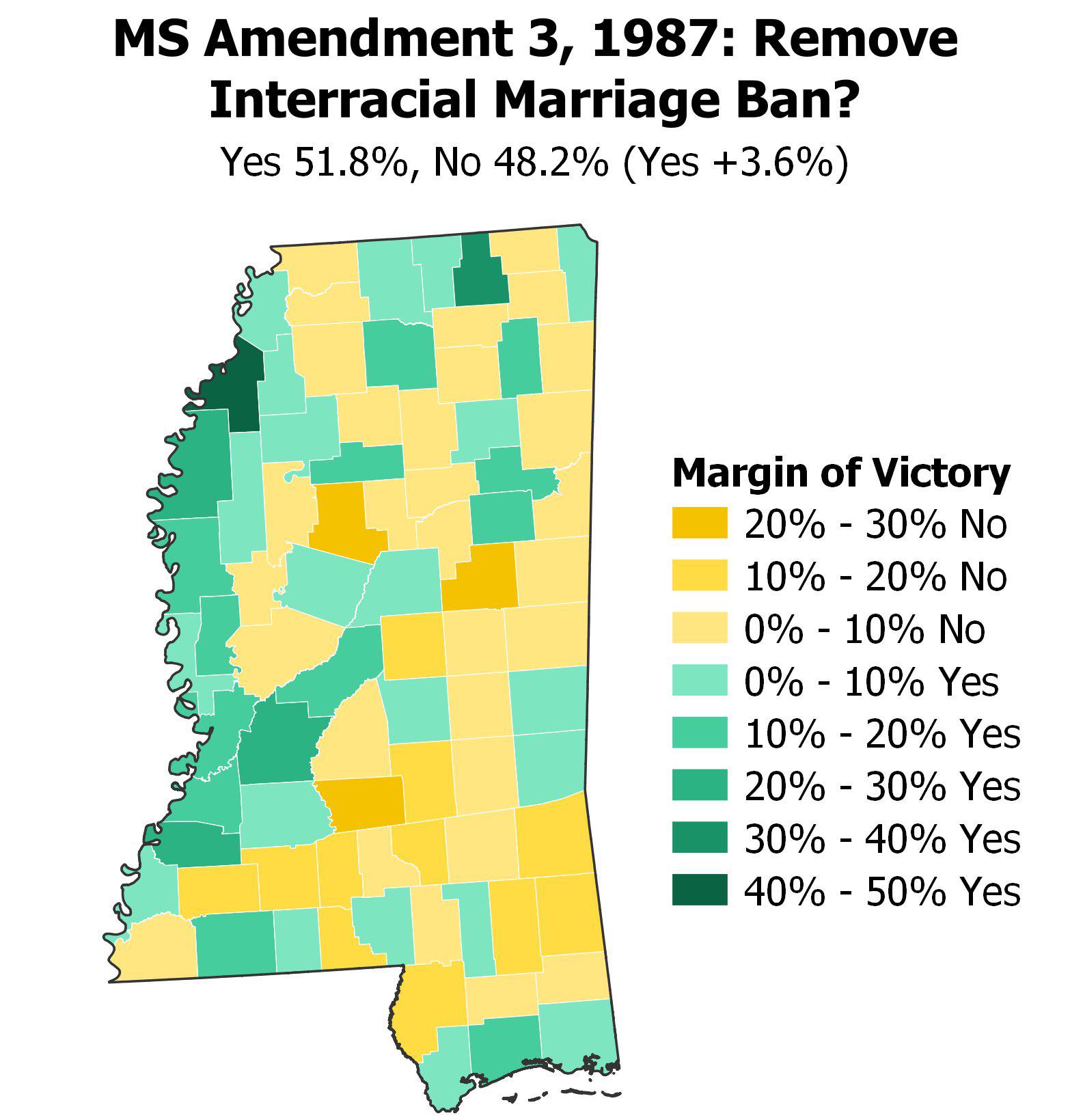Map of Interracial Marriage Ban Removal in Mississippi


Alex Cartwright
Senior Cartographer & GIS Specialist
Alex Cartwright is a renowned cartographer and geographic information systems specialist with over 15 years of experience in spatial analysis and data...
Geographic Analysis
What This Map Shows
This map visualizes the historical context surrounding the removal of the inactive interracial marriage ban in Mississippi, officially lifted by a ballot measure in 1987. While the ban had been rendered unenforceable by the 1967 Supreme Court case Loving v. Virginia, which invalidated similar prohibitions nationwide, Mississippi's government took a notable amount of time to formally erase this remnant of segregationist policy from its legal framework. This visual representation not only marks the geographical implications of this legislative change but also serves as a window into the broader social dynamics of race relations in the state.
Deep Dive into Interracial Marriage Legislation
Interracial marriage laws in the United States, particularly in the South, are a vivid reflection of the historical struggles regarding race and civil rights. Prior to the landmark decision in Loving v. Virginia, many states, including Mississippi, enforced strict bans on interracial marriages, rooted deeply in the societal norms of the Jim Crow era. These laws aimed to maintain the racial hierarchy and prevent the mixing of races, reflecting a pervasive institutionalized racism prevalent in many parts of the country.
Interestingly, Mississippi's 1987 ballot measure to remove the ban was not merely a legal formality but a culmination of decades of social change. The first interracial marriage in Mississippi was officially approved in 1970, just a few years after the Loving decision, indicating a gradual shift in public sentiment. However, the state’s reluctance to officially remove the ban until 1987 underscores the complex interplay between law, culture, and societal acceptance.
In terms of demographics, Mississippi is often characterized by its unique racial composition, with a significant African American population. The removal of the interracial marriage ban represents not only a legal victory but also an acknowledgment of the changing dynamics in the state's demographic landscape. By the 1980s, societal attitudes were beginning to shift, with increasing acceptance of interracial relationships, particularly among younger generations.
Moreover, the history of interracial marriage in Mississippi reveals a broader narrative of social evolution. It highlights how deeply entrenched beliefs can be challenged over time, leading to more inclusive practices. The map serves as a reminder of the progress made, but also of the work still required to overcome racial biases and foster a more equitable society.
Regional Analysis
Breaking down the map further, one can observe the varying degrees of acceptance and enforcement of interracial marriage laws across different regions in Mississippi. Urban areas, particularly cities like Jackson and Biloxi, showcased a more progressive stance compared to rural counties, which often held onto traditional views longer. For instance, in Jackson, the demographic diversity and urbanization led to a more multicultural acceptance, contributing to higher rates of interracial marriages compared to more conservative rural areas.
Interestingly, the cultural vibrancy in Mississippi's urban centers has played a significant role in shaping attitudes towards interracial relationships. The coalescence of various cultural influences in these regions has fostered a more open mindset, contrasting sharply with the historical context of the state. In contrast, regions with a strong adherence to traditional values and a slower pace of social change often lagged behind in the acceptance of interracial marriage, reflecting broader national trends of urban versus rural divides.
Moreover, the socio-economic factors also contribute to these variations. Access to education and economic opportunities often influences people's views on race and relationships. Regions with higher educational attainment tend to show more progressive attitudes towards interracial relationships. This map not only highlights the legal changes but also serves as a reminder of the socio-cultural dynamics at play throughout Mississippi.
Significance and Impact
The significance of removing the interracial marriage ban in Mississippi extends beyond just the legal framework; it symbolizes a shift towards inclusivity and acceptance in society. This legislative change represents a pivotal moment in the ongoing fight for civil rights and equality, embodying the struggles faced by countless individuals who sought the freedom to love without racial boundaries.
Have you noticed how the legacy of such laws continues to shape discussions around race relations today? As we reflect on this historical moment, it is crucial to recognize the ongoing impacts of these policies on contemporary society. The removal of the ban is a testament to the progress made, but it also serves as a reminder of the challenges that lie ahead in promoting racial harmony and equality.
Looking forward, the trends indicate a continued movement towards acceptance of interracial relationships, especially among younger generations. With increasing intermarriage rates across the United States, including Mississippi, it’s clear that love transcends racial boundaries. However, the work doesn’t end with the removal of outdated laws; ongoing education and dialogue are essential to combatting racism and fostering a truly inclusive society.
In conclusion, this map serves not just as a historical artifact but as a living testament to the changing tides of social norms and the importance of understanding our past to inform our present and future.
Visualization Details
- Published
- September 17, 2025
- Views
- 72
Comments
Loading comments...